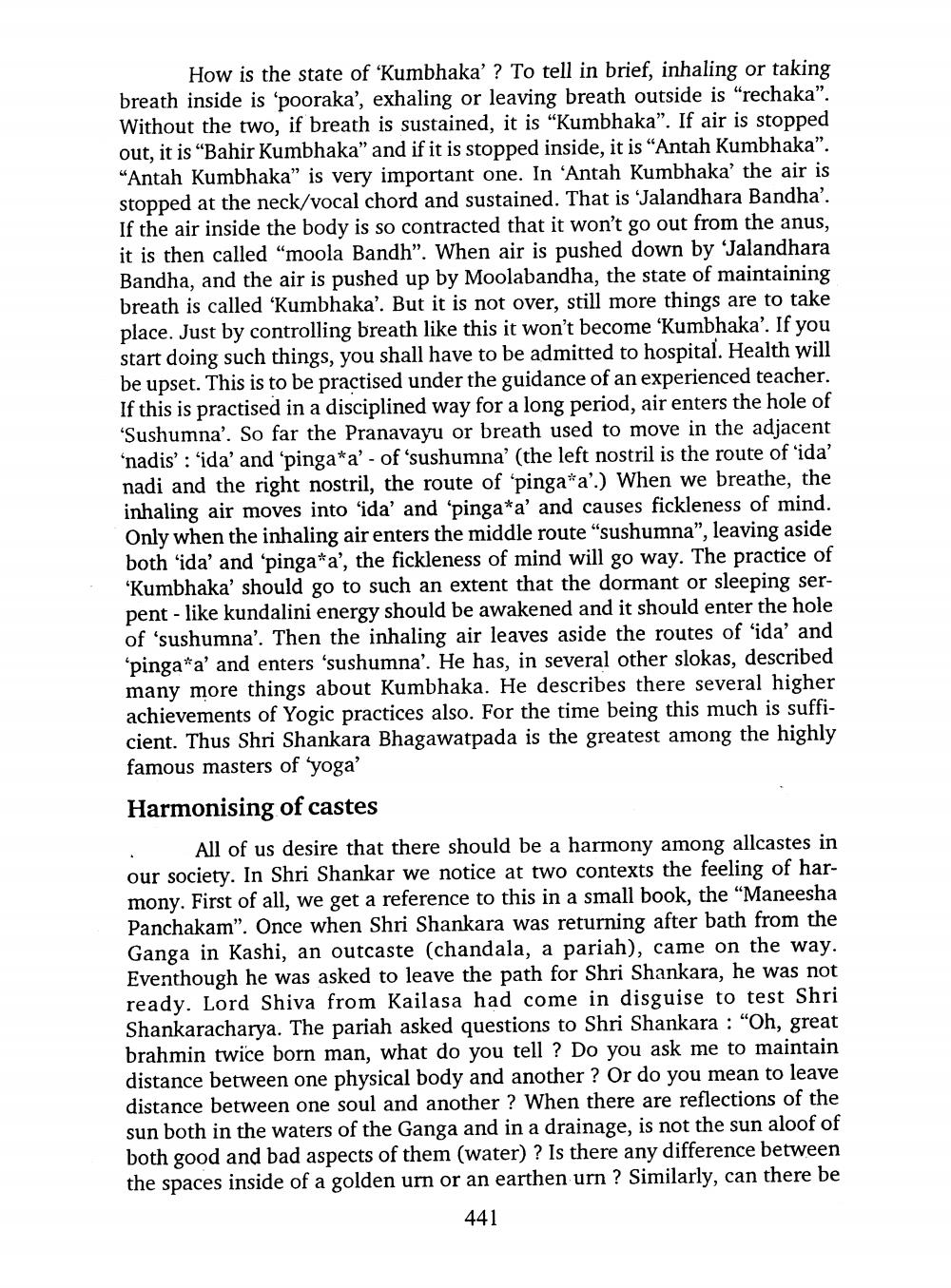________________
How is the state of 'Kumbhaka'? To tell in brief, inhaling or taking breath inside is 'pooraka', exhaling or leaving breath outside is "rechaka”. Without the two, if breath is sustained, it is “Kumbhaka”. If air is stopped out, it is “Bahir Kumbhaka" and if it is stopped inside, it is “Antah Kumbhaka”. "Antah Kumbhaka” is very important one. In 'Antah Kumbhaka' the air is stopped at the neck/vocal chord and sustained. That is 'Jalandhara Bandha'. If the air inside the body is so contracted that it won't go out from the anus, it is then called "moola Bandh". When air is pushed down by 'Jalandhara Bandha, and the air is pushed up by Moolabandha, the state of maintaining breath is called 'Kumbhaka'. But it is not over, still more things are to take place. Just by controlling breath like this it won't become 'Kumbhaka'. If you start doing such things, you shall have to be admitted to hospital. Health will be upset. This is to be practised under the guidance of an experienced teacher. If this is practised in a disciplined way for a long period, air enters the hole of 'Sushumna'. So far the Pranavayu or breath used to move in the adjacent ‘nadis' : 'ida' and 'pinga*a'- of ‘sushumna' (the left nostril is the route of ‘ida' nadi and the right nostril, the route of 'pinga a'.) When we breathe, the inhaling air moves into 'ida' and 'pinga*a' and causes fickleness of mind. Only when the inhaling air enters the middle route “sushumna”, leaving aside both 'ida' and 'pinga*a', the fickleness of mind will go way. The practice of "Kumbhaka' should go to such an extent that the dormant or sleeping serpent-like kundalini energy should be awakened and it should enter the hole of 'sushumna'. Then the inhaling air leaves aside the routes of 'ida' and 'pinga*a' and enters 'sushumna'. He has, in several other slokas, described many more things about Kumbhaka. He describes there several higher achievements of Yogic practices also. For the time being this much is sufficient. Thus Shri Shankara Bhagawatpada is the greatest among the highly famous masters of yoga' Harmonising of castes
All of us desire that there should be a harmony among allcastes in our society. In Shri Shankar we notice at two contexts the feeling of harmony. First of all, we get a reference to this in a small book, the “Maneesha Panchakam". Once when Shri Shankara was returning after bath from the Ganga in Kashi, an outcaste (chandala, a pariah), came on the way. Eventhough he was asked to leave the path for Shri Shankara, he was not ready. Lord Shiva from Kailasa had come in disguise to test Shri Shankaracharya. The pariah asked questions to Shri Shankara : “Oh, great brahmin twice born man, what do you tell ? Do you ask me to maintain distance between one physical body and another ? Or do you mean to leave distance between one soul and another ? When there are reflections of the sun both in the waters of the Ganga and in a drainage, is not the sun aloof of both good and bad aspects of them (water)? Is there any difference between the spaces inside of a golden urn or an earthen urn? Similarly, can there be
441




